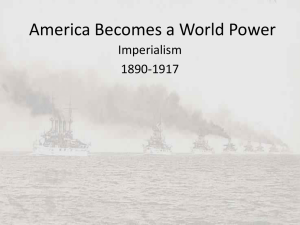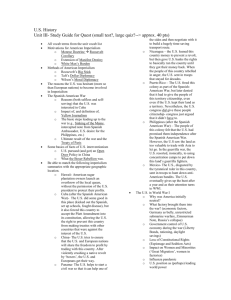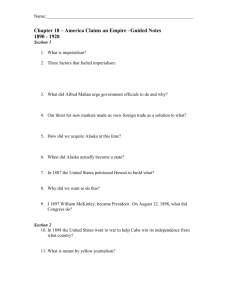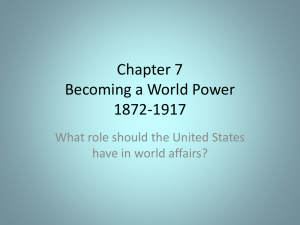File
advertisement
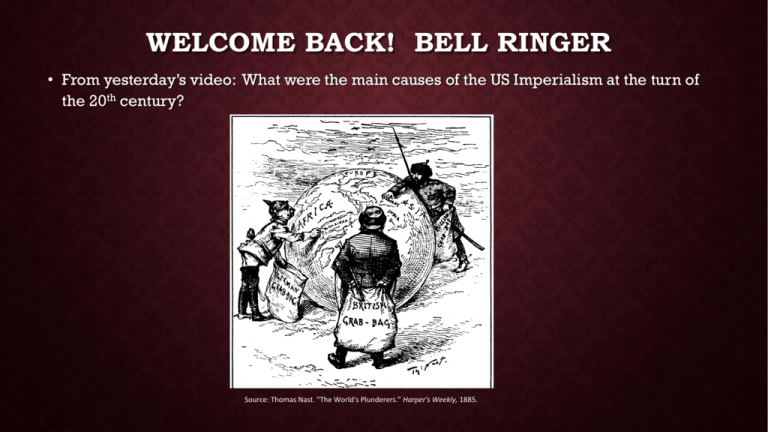
WELCOME BACK! BELL RINGER • From yesterday’s video: What were the main causes of the US Imperialism at the turn of the 20th century? Source: Thomas Nast. "The World's Plunderers." Harper's Weekly, 1885. WELCOME BACK! • Bell Ringer: Analyze the following political cartoons. What do these cartoons says about the justification of Imperialism at the turn of the 20th century? AGENDA AND OBJECTIVE • Agenda: Imperialism Ranking Activity, Primary source analysis activity • Objective: Through note review, discussion, and analyzing primary sources, students will defend arguments over motives and consequences of American Imperialism at the turn of the 20th century. ACTIVITY #1 IMPERIALISM RANKINGS • Defend your opinion on 1. What was the major motive of US Imperialism 2. The main cause of the Spanish American War. 3. Which President has the most influential Foreign Policy and 4. Reasons for and against Imperialism WHAT IS IMPERIALISM? • Exerting control over another nation • By means of economic, political, and/or military control • Can be connected with Jingoism (extreme nationalism led by a pro-war foreign policy) PRIOR TO THE 1890’S THE US WAS NOT INTERESTED IN EXPANSION…WHY? • The Civil War • Expanding westward (Manifest Destiny!) • Staying away from foreign alliances and wars BY THE 1890’S THE US WAS READY TO EXPAND…WHY? • Competition with Europe, especially Great Britain, France, and Germany • Adhering to the politics and ideology of race (Rev. Josiah Strong, Social Darwinism) • The development in the importance of Naval power (Adm. Alfred Mahan) • Looking for new economic markets AMERICAN INTERESTS IN IMPERIALISM • Samoa • Became a protectorate in the 1870’s • A weak country under the protection and partial control of a strong country. HAWAII HAWAII • Early missionaries bought large amounts of land for sugar plantations • By 1880’s, US using Pearl Harbor as a naval base • Many wanted US out, including Queen Liliuokalani. Was overthrown in 1893 • Became a Republic with Sanford Dole as first Governor. SPANISH AMERICAN WAR “A Splendid Little War” - 1898 Spanish-American War was fought in 2 theaters: Cuba & the Philippines “A splendid little war” The war lasted only 113 days & only 379 Americans died in battle Cuba The Tariff of 1894, which put restrictions on sugar imports to the United States, severely hurt the economy of Cuba which was then a Spanish colony. Angry nationalists began a revolt against the Spanish colonial regime. Causes of the Spanish-American War • Cuban Revolution • Proximity of Cuba to United States • Yellow Journalism • The De Lôme Letter • The sinking of the battleship “Maine” The Spanish in Cuba • Cuban guerrilla fighters burned sugar mills and plantations so the Spanish responded with “reconcentrato” which was camps for Cuban civilians to deny material and moral support to freedom fighters • Spanish put Cuba under martial law • By 1898, 1/3 of Cubans were in camps – more than 4,000 died from lack of medicine, poor nutrition and unsanitary conditions United States Foreign Policy 1890-1914 The Cuban Revolt: America to the Rescue? Cuba vs. Spain-Spanish rule oppressed the Cubans. Cubans revolt. Spain responds by sending General “Butcher” Weyler to crush the rebellion. Cuban rebels placed in concentration camps (many died due to poor sanitation). America Backs Cuba-Sentimental: Cuba was the underdog. Economic: American businesses traded $100 million/year. Political: Spain is a dying empire in America’s sphere of influence. Whoever controls Cuba controls a potential Panama Canal. Yellow Journalism-Hearst vs. Pulitzer. Each 16 reported on the atrocities in Cuba. Sensationalized news equals more readers. Hearst printed the De Lome Letter (Spanish letter calling President McKinley weak and a puppet). IN EFFORT TO GAIN SUPPORT FOR THE CUBANS MANY NEWSPAPERS RAN STORIES THAT WERE EXAGGERATED AND UNTRUE… • The two most famous editors of the time were Joseph Pulitzer… • …and William Randolph Hearst “You furnish the pictures…I’ll supply the War” De Lôme Letter Spanish Minister to the US Enrique Dupuy de Lôme wrote a letter to a friend in Cuba about how President McKinley was weak and a low politician. “It once more shows what McKinley is, weak and a bidder for the admiration of the crowd besides being a wouldbe politician who tries to leave the door open behind himself while keeping on good terms with the jingoes of his party.” United States Foreign Policy 1890-1914 The U.S.S. Maine Explosion and War The USS Maine-US battleship sent to Cuba to protect and evacuate Americans if rebellion intensified. On 2/15/1898 the Maine exploded in Havana harbor (260 sailors killed). “Remember the Maine, to Hell with Spain.” Results-Two investigations. Spanish: Explosion was accidental and internal (not confirmed until 1976 US Navy investigation). American: Explosion caused by Spanish mine. The American public is ready for war! McKinley and War-President McKinley was conflicted. He didn’t want a war, yet he didn’t want Spain to control Cuba. McKinley eventually yields to public and US business pressure. The US declares war on Spain (4/11/1898). 19 WAR FEVER!! • In Feb. 1898 While protecting Americans in Cuba, the USS Battleship Maine exploded in Havana Harbor killing 260 men. • “Remember the Maine” became a war slogan. Teller Amendment ◻ United States "hereby disclaims any disposition of intention to exercise sovereignty, jurisdiction, or control over said island except for pacification thereof, and asserts its determination, when that is accomplished, to leave the government and control of the island to its people." THE CUBAN CAMPAIGN • US Army had a tougher time… why? • Heat and wool uniforms • Spread of disease • Ill prepared and ill trained THE ROUGH RIDERS • Led by former Secretary of Navy Theodore Roosevelt, this rag tag Calvary unit led the charge up San Juan Hill • Or did they? They actually attacked Kettle Hill! The Rough Riders ◻ Organized by Theodore Roosevelt ◻ Participated in the Battle of San Juan Hill Buffalo Soldier, Dreadlock Rasta: There was a Buffalo Soldier in the heart of America, Stolen from Africa, brought to America, Fighting on arrival, fighting for survival. I mean it, when I analyze the stench • a2,000 African American To me it makes lot of sense: How the Dreadlock Rasta was the Buffalo soldiers comprised of Soldier, And he was taken from Africa, brought to America, Regular Army regiments, Fighting on arrival, survival. the fighting 9th andfor10th Cavalry and the 24th and 25th Said he was a Buffalo Soldier, Dreadlock Rasta Infantry. Buffalo Soldier in the heart of America. • Joined the Rough Riders for battle of San Juan and If you know yourthe history, Hillsyou coming from, Then you wouldKettle know where Then you wouldn't have to ask me, Who the 'eck do I think I am. I'm just a Buffalo Soldier in the heart of America, Stolen from Africa, brought to America, Said he was fighting on arrival, fighting for survival; Said he was a Buffalo Soldier win the war for America. BUFFALO SOLDIERS RESULTS - Platt Amendment ◻ Cuba prohibited from making treaties with other countries and was forced to cede Guantanamo Bay to the US for use as a naval base. ◻ US has "the right to intervene for the preservation of Cuban independence, the maintenance of a government adequate for the protection of life, property, and individual liberty..." The Philippines “Shall we grant them independence at once or are we right to show them that they cannot be made fit for independence at once?” – William Howard Taft United States Foreign Policy 1890-1917 Latin America: Puerto Rico Background-Puerto Rico had been acquired as part of the treaty ending the Spanish American War. Foraker Act 1900-Puerto Rico becomes an unincorporated territory and as such the people are citizens of Puerto Rico. Jones Act 1917-Gave full territorial status to Puerto Rico and US citizenship to the people. There were some differences with regular citizens - could not vote in presidential elections, elected their own legislators (no Congressional representation), and a governor enforced the laws. 29 Battle of Manila Newspaper Headline Battle of Manila ◻ May 1, 1898 – US fleet attacked the Spanish squadron in Manila, the capital of the Philippines. ◻ Within 7 hours the US ships had destroyed the entire Spanish fleet of 10 ships! ◻ Not enough ground troops so US had to get the help of Filipinos. ◻ August 13th US forces capture Manila. ◻ Filipinos thought the US would grant their independence after Spain was defeated. American Territories Acquired: Treaty of Paris 8/12/1898 (114 days!) ◻ After the Spanish American War, the US added 100,000 square miles and close to 10 million people to the American Empire. ◻ It acquired the following territories for a payment of $20 million to Spain: ⬜ Puerto Rico ⬜ Guam ⬜ Philippines (Granted Independence after WWII) Need for places to refuel ships on their way to trade in Asia. Asia Opened Up China & Japan US WAS ALSO INTERESTED IN EXPANDING IN THE FAR EAST • Interested in China • American merchants feared they would be left out of trade markets • A weak country who was carved up into “spheres of influence” by Europe IN RESPONSE, SECRETARY OF STATE JOHN HAY AUTHORED THE “OPEN DOOR POLICY” Sent Diplomatic notes to Russia, France, Germany, Britain, and Japan asking them for equal trading rights and transportation facilities in China United States Foreign Policy 1890-1914 America in Asia: China and the Open Door Open Door Policy-China is a weak country in the 1890s. European powers had basically spit China into spheres of influence. (1899) Secretary of State John Hay urged European leaders respect Chinese rights and fair competition (this is the Open Door) Boxer Rebellion-(1900) Super-patriotic group of Chinese trained in martial arts murdered foreigners and Christians. A multinational force (including American soldiers) stopped the rebellion. Results-Gave all nations equal trading Open Door – Asia: 400,000,000 potential consumers in China alone 36 access in China. Guaranteed that China would not be taken over by a foreign power. HOWEVER, MANY CHINESE DID NOT WANT WESTERNS IN CHINA… • “Boxers” killed over 200 missionaries and other whites and besieged foreign diplomats in Beijing • Did not succeed “…destroy the foreigner!" A Multi-National Force Put Down the Boxer Rebellion From left: Britain, U.S., Australia, British India, Germany, France, Austria-Hungary, Italy, Japan United States Foreign Policy 1890-1914 America in Asia: Japan Before 1890-Japan had been an isolated country for 200 years until Commodore Matthew Perry sailed into Tokyo demanding they open to trade. 1854 - Treaty of Kanagawa - opened 2 ports 1858 - Treaty of Anmity & Commerce Results- Trade agreements weakened Japan and led to the overthrow of the Shogunate and establishment of a new government. TAFT-KATSURA AGREEMENT: 1905 SECRET AGREEMENT THAT GAVE JAPAN CONTROL OF THE KOREAN PENINSULA, EVEN THOUGH KOREA WAS A 39 FRIEND OF THE US. After 1900- 1905 - Treaty of Portsmouth 1908 - Root-Takahira Agreement 1908 - Gentlemen’s Agreement Gentleman’s Agreement: A Japanese note agreeing to deny passports to laborers entering the U.S. In exchange, The U.S. government got the school board of San Francisco to rescind their order to segregate Asians in separate schools. Root-Takahira Agreement: 1908 A pledge to maintain the status quo in the Far East. Recognition of China’s independence and territorial integrity, and support for continuation of the Open-Door Policy. An agreement to mutual consultation in the event of future Far Eastern crises. Great White Fleet - nickname for the US battle fleet that went around the world from December 1907 January 1909. The purpose was to show America’s military power. Through Congressional funds, the navy was converted from a wooden ship fleet into a modern, steel ship navy. Latin America American Imperialism in the Western Hemisphere FOCUS OF US FOREIGN POLICY SHIFTS TO CENTRAL AMERICA AFTER THE WAR • Was premised by the Monroe Doctrine • That US would stay out of Europe and of 1823 would oppose European intervention in the Western Hemisphere U.S. Dominance in Latin America Under Teddy Roosevelt (1901-1909): ⚫Roosevelt Corollary to the Monroe Doctrine (“Big Stick Diplomacy”) ⚫Panama Canal Latin America American Imperialism in the Western Hemisphere Monroe Doctrine, 1823 ◻ The Western Hemisphere was no longer open to colonization by European nations and that the US would not interfere in purely European affairs and that European nations had no right to interfere in the affairs of existing Western Hemisphere nations. ◻ Applied ⬜ 1895 boundary dispute Guiana & Venezuela • Gold was discovered, Britain warned to not take territory, refused international arbitration until US threatened war Attitude of Latin Americans ◻ Gratitude for protection against European influence ◻ Resentment of the position of superiority assumed by the US US Involvement in Western Hemisphere ◻ Big Stick Diplomacy – Roosevelt ◻ Dollar Diplomacy – Taft ◻ Moral Diplomacy – Wilson ◻ Diplomacy: Art of negotiating between nations. ◻ Purpose: to protect US business interests in Latin America United States Foreign Policy 1890-1914 Theodore Roosevelt’s Foreign Policy: Carry a Big Stick “Speak softly and carry a big stick” Roosevelt Corollary-Preventative intervention. US would intervene in Latin America to keep European powers out of the Western Hemisphere. Corollary Results-Used to justify all interventions. US Marines will be sent multiple times to Latin American countries. Latin American countries views this as American oppression. Roosevelt in Action-Roosevelt was not 50 afraid to flex American muscle. (1902) Germany sank 2 Venezuelan boats during an attempt to collect a debt. Changed the policy by paying debts to avoid European interference in Western Hemisphere. (1903) Sent the US Navy to protect the Panamanian revolt over Colombia. United States Foreign Policy 1890-1914 American Power: Building the Panama Canal Background-US needs a two ocean navy to protect interests. Spanish-American war demonstrated the lack of mobility. Rights to the Canal-Hay-Pauncefote Treaty (1901). Authorized the US to construct and manage a Central American canal. The canal was to be open to all nations and rates to be fair and equal. (1902) Congress chose the Panama route. Revolution-Panama was part of Colombia. Colombia rejected $10 million and $250,000/year. (1903) the US navy supported Panamanian revolt. US recognized independent Panama 3 days after revolt. 51 Construction-(1904-1914). Cost $400 million. Problems with labor, landslides, and disease. BUT WHERE SHOULD THE CANAL BE BUILT? • First place considered was Nicaragua. Was free of disease and only had about 50 miles to dig… • However in 1902 a volcano exploded on the island of Martinique. US believed to be unsafe OPTION NUMBER TWO…PANAMA HOWEVER PANAMA WAS CONTROLLED BY COLUMBIA… • Knowing that Panama was unhappy under Columbian rule, a revolution was staged with the help of the French Canal agent Philippe BunauVarilla • the new Foreign Minister Bunau-Varilla! • Roosevelt supported “I took the the revolution, sending navy to ensureCanal” victory • US quickly recognized Panama and negotiated a treaty with… BUILDING THE CANAL… • Had to deal with disease. Over 5,600 workers died • Army Physician, William Gorgas was able to wipe out yellow fever by draining local water areas More than 43,000 laborers worked on the Canal. Were divided into Gold and Silver Star Workers Most work was done with pick ax, shovel, and dynamite. Work ended in 1914 with the cost of 352 million Traveling through the canal takes approximately 10-12 hours The water route from New York to San Francisco was 8,000 miles shorter Allowed Navy to move quicker On December 31, 1999 the canal was returned to the government of Panama “The land divided, the world united” United States Foreign Policy 1890-1914 William H. Taft’s Foreign Policy: Dollar Diplomacy Background-Federal government encouraged Wall Street bankers and other major US corporations to invest in foreign countries that were of a strategic concern to the US. The dollar would replace Roosevelt’s big stick. Dollar Diplomacy in the Caribbean-Main area of US strategic importance. US pumped money into this area to keep other countries out and to uphold the Monroe Doctrine. Policy failed when civil distress broke out in Cuba, Honduras, and the Dominican Republic. President Taft had to send in the Marines to protect American investments. 59 United States Foreign Policy 1890-1914 Woodrow Wilson’s Foreign Policy: Moral Diplomacy Background-Wilson hated Roosevelt’s big stick and Taft’s dollar diplomacy. Wilson believed that the US would be the world’s conscience. Goal of American foreign policy would be to spread democracy and promote peace. Wilson in Action-Sometimes spreading democracy required military action. Wilson sent the Marines to Haiti (1914-1933) and the Dominican Republic (1916-1924). (1916) Jones Act granted the Philippines territorial status and promised independence America’s Mexican Adventure-American "The force of America is the force of moral principle." 60 Woodrow Wilson. companies invested billions of dollars in Mexican oil, railroads, and mines. (1913) Mexican people rebelled. (1914) Wilson sent the Navy to capture the port of Vera Cruz. (1916) Wilson ordered General Pershing to break up Pancho Villa’s group. (1917) US withdrew because threat of war with Germany increased. WOODROW WILSON AND LATIN AMERICA • Was weary of dollar diplomacy • Believed that heavy investment would actually harm weak nations • Feared that investors would take all profits and influence local governments ONE AREA OF CONCERN FOR WILSON WAS MEXICO… • Ruled by dictator Porfilio Diaz who was a friend of the United States • However Madero was executed, allowing Victoriano Huerta to proclaim himself ruler of Mexico • In the revolution of 1911, Diaz was overthrown by Francisco Madero SHIFT IN AMERICAN FOREIGN POLICY!! • Wilson refused to recognize new government set up by Huerta… • Government now must be based on free elections before US will recognize… • In response, Heurta arrested Americans in Mexico. US sent Navy to port city of Vera Cruz… • The United States supported two local revolutionaries to help overthrow Heurta… • Venustiano Carranza • And Pancho Villa Huerta was eventually overthrown in 1916 with the United States supporting Carranza… Villa was determined to gain control by attacking a train in Northern Mexico, killing 12 Americans US troops Wilson threatened by were never sending troops. able to find Villa went on a Villa. Ends killing spree up being across the Rio assassinated Grande killing 3 insoldiers 1923.and a boy But Wilson had other worries… WORLD WAR I U. S. Interventions in Latin America: 1898-1920s ACTIVITY #2 WHAT ARE THE POSITIVES AND NEGATIVES OF BUILDING AN EMPIRE? • Identify how your documents support/refute American Imperialism. United States Foreign Policy 1890-1914 Just Say No To Empire: The Anti-Imperialist League Background-Most of America were part of the contiguous United States (minus Alaska and Hawaii). The Philippines were a distant tropical island chain with a different culture. Main goal of the Anti-Imperialist League was to fight the McKinley administration’s expansionist policies. Prominent leaders included Mark Twain and Andrew Carnegie. Anti-Imperialist Objections- Declaration of Independence and the Constitution state it is the right of the people to choose their form of government. Imperialism was against America’s anti-colonial policy. Imperialism would be too costly. Annexation would pull the US politically and militarily into Asia (okay to be pulled economically). 70 United States Foreign Policy 1890-1914 American Empire: Did the Constitution Follow the Flag? Puerto Rico-Ceded to the US as payment for war costs. Foraker Act (1900) granted Puerto Rico limited government. American citizenship granted (1917). Still a US possession (neither a state nor a territory). Cuba-Teller Amendment (1898) promised Cuban independence. However US didn’t want Cuba taken over by Germany or other imperial power. Platt Amendment (1901) US could intervene to preserve Cuban independence. US kept land for a naval base (Guantanamo Bay) Hawaii- 71 (1893) first attempt at annexation. First full-fledged imperialistic debate. Halfway to the Philippines. Fear of Japanese takeover while the US was busy with Spain. Annexed 7/7/1898. Full territorial status (1900). Insular Cases (1901-1903) ◻ Debate over whether or not the rights granted to citizens of the US applied to those people living in American territories. ◻ Supreme Court declared that not all provisions of the Constitution needed to apply to those who lived under the American flag but outside the continental boundaries of the US.

